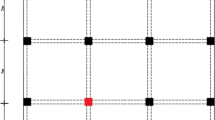Abstract
In the event of an earthquake of a large magnitude, it is extremely important for RC structures to retain their stability and be resistant towards collapse so as to help save lives and to minimise major structural damages. Capacity-based design adopted in the design of RC structures leads towards progressive collapse. Progressive collapse is an event where damage in a portion of an RC structure causes further failure of the structural elements that are located near the zone of damage. The damage takes place in the structure in the form of plastic hinges, which are formed at particular sections in structural members (RC beams and columns) on account of reversal of stresses due to earthquake loads. There is plastic rotation that takes place at these plastic hinges, especially in vertical RC structural members (RC columns) that cause large lateral storey displacements leading towards complete or partial collapse of the RC structure that needs to be avoided. In the present work, a nine-storey RC hospital building built in zone V and subjected to earthquake loads has been considered for the study. Nonlinear pushover analysis has been carried out on the nine-storey RC hospital building that has plan irregularities. The plastic hinges formed in the structural members (RC beams and columns) present in the hospital building are identified after carrying out nonlinear pushover analysis. The lateral storey displacements due to formation of the plastic hinges and the stability of the structure is assessed. Critical zones in the structure are identified, where the structural members present have undergone distress on account of formation of plastic hinges that have plastified. Global retrofit methods considering introduction of new RC shear walls and bracings in the RC hospital building have been individually applied to restore the lateral stability of the structure. Local retrofit method such as RC jacketing is applied on to the distressed structural elements (RC beams and columns) that are present in the critical/damaged zone of the structure. Analysis has been carried out considering individual combinations of the global and local retrofits to arrive at a safe and optimised retrofit solution so as to reduce the possibility of progressive collapse, lateral storey displacements, reduce the number of plastic hinges formed and to restore the stability of the structure subjected to earthquakes.
Access this chapter
Tax calculation will be finalised at checkout
Purchases are for personal use only
Similar content being viewed by others
References
Petrone F, Shan L, Kunnath SK (2016) Modeling of RC frame buildings for progressive collapse analysis. Int J Concr Struct Mater 10:1–13
Nethercot DA (2011) Design of building structures to improve their resistance to progressive collapse. Proc Eng 14:1-13O
IS 875 (Part 2) (1987, Reaffirmed 2008) Code of practice for design loads (other than earthquake) for building and structures-imposed loads. Bureau of Indian Standards, New Delhi
Tsai M-H, Huang T-C (2011) Progressive collapse analysis of an RC building with exterior non-structural walls. Proc Eng 14:377–384
Mohan Kumar S, Jeyanthi R (2016) Progressive collapse analysis of a multistorey RCC building using pushover analysis. Int J Eng Res Technol 05:747–750
Sunamy SL, Binu P, Girija K (2014) Progressive collapse analysis of a reinforced concrete frame building. Int J Civ Eng Technol 12:93–98
Raghavendra C, Pradeep AR (2014) Progressive collapse analysis of reinforced concrete framed structure. Int J Civ Struct Eng Res 1:143–149
Helmy H, Mourad S (2003) Computer aided assessment of progressive collapse of reinforced concrete structures according to GSA code. J Perform Constr Facil 529–539
Bracci JM, Kunnath SK, Reinhorn AM (1997) Seismic performance and retrofit evaluation of reinforced concrete structures. J Struct Eng 123(1):3–10
IS 1893-Part 1 (2016) Criteria for earthquake resistant design of structures. Bureau of Indian Standards, New Delhi
IS 456(2000) Plain and reinforced concrete—code of practice. Bureau of Indian Standards, New Delhi
Author information
Authors and Affiliations
Corresponding author
Editor information
Editors and Affiliations
Rights and permissions
Copyright information
© 2023 The Author(s), under exclusive license to Springer Nature Singapore Pte Ltd.
About this paper
Cite this paper
Mohamed Saqlain, C.K., Guruprasad, Y.K. (2023). Improving Resistance Towards Progressive Collapse of RC Structures Subjected to Seismic Loads. In: Saha, S., Sajith, A.S., Sahoo, D.R., Sarkar, P. (eds) Recent Advances in Materials, Mechanics and Structures. Lecture Notes in Civil Engineering, vol 269. Springer, Singapore. https://doi.org/10.1007/978-981-19-3371-4_46
Download citation
DOI: https://doi.org/10.1007/978-981-19-3371-4_46
Published:
Publisher Name: Springer, Singapore
Print ISBN: 978-981-19-3370-7
Online ISBN: 978-981-19-3371-4
eBook Packages: EngineeringEngineering (R0)




